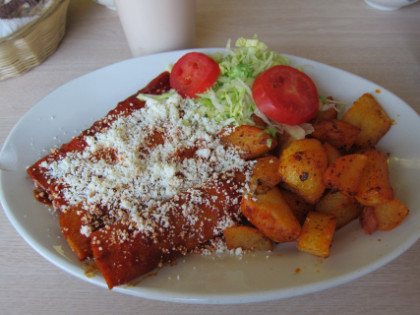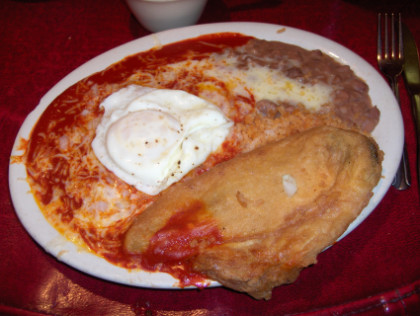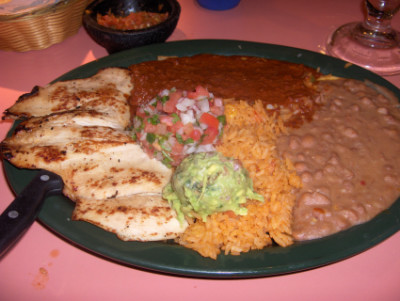One of the projects I thought would be good to include in this blog is a list of recommended restaurants in various cities, which I call Steve’s List. Some restaurants listed are based on my personal experience, but most come from reviews I have found from various sources on the Internet. This effort is to find the best restaurants of various cuisines and in various geographic locations, but also to keep the list narrowed down to a manageable size. I hope the list will be of value for those who are looking for interesting experiences that do not focus on tourist traps and the lowest common denominator food.
So far I have published lists for all of the Southwestern states, and based on my research and past experience, I believe that these states are particularly notable for their Mexican food. This seemed to be a good time to create a list of the “Top Ten Cities in the United States for Mexican Food.” It is just my personal list, and I am unsure about the order that some cities should be placed, but it seemed very evident to me about which cities should be the top ten.
The list of top ten Mexican food cities is based on both the quality and quantity of Mexican food available (and is limited to larger cities). The factors I use to determine the top cities include the number of “top restaurants” (which ideally should include both high end alta cocina restaurants and specialized restaurants which provide a variety of foods from certain areas of Mexico). I am also looking for a general Mexican food culture which supports things such as markets, bakeries, and small restaurants. In the end, though, it is not the number of businesses but the quality of them, and for this I turn to my own experience and the reviews I see on the Internet.
It seems to me that no cities outside of the Southwest would qualify as having a general Mexican food culture, although many have a large number of restaurants with a variety of food. My experience is that once you get a certain distance away from the Mexican border the “default” style and flavor of the food is Americanized in a way that gets very far away from the original style of Mexican food. These cities tend to have a few good restaurants and many that have a bland sameness. I do not want to knock people’s tastes for Americanized food, but I think a great number of people like the authentic food once they have a chance to try it (but too many cities do not provide that chance). We can always go back to the old style Mexican “comfort food,” but I think good Mexican food cities should also provide other choices.
The question of the American styles of Mexican food (Tex-Mex, New Mexican, Sonoran, and Californian) is an interesting one. I do not consider any of these to be authentic Mexican food, but they are based on food from Mexico (in contrast, the “Americanized” Mexican food I talk about is some way that Mexican dishes are modified to the point that they have more American elements than Mexican ones).
All of the cities I list as being in the top ten Mexican food cities are in states which have traditionally been home to the Tex-Mex, New Mexican, Sonoran, or California styles of Mexican food. A search of restaurant reviews on the Internet demonstrates that all the cities on my list have evolved from the original Mexican food styles to more diverse styles, as if these four styles are really a stepping stone for people to appreciate authentic Mexican food. People in these cities seem to embrace authentic food from Mexico when these types of restaurants open up, and restaurants find a customer base for what they offer.
My disclaimer here is that I have not eaten in enough restaurants in enough cities to say that I can make a definitive list of the best Mexican food cities. Still, I have some experience, and through scouring the Internet I am able to make some assumptions about the best cities for good quality Mexican food.
Some of the cities I am excluding do have some very good Mexican food. For instance, Chicago is the home of the Rick Bayless restaurants, where many believe you can get the best Mexican cuisine in the country. I have not tried them personally, but I have a pretty good idea that this is not far from the truth. Nevertheless, Chicago does not seem to have a large saturation of taco shops and the kind of small restaurants that I think would be present in one of the “top ten” cities. I believe that Chicago and other very large cities have some very good Mexican food, but it does not seem to be widespread throughout the city and the region.
I will also say that I do not have enough knowledge of some cities which I think could be possible candidates. These would include some cities in California such as San Francisco, Sacramento, and Fresno (I have been to Fresno but I would not place it in the top ten). Some cities which I am purposely excluding from the top ten include Las Vegas and Denver (I was not very impressed with either one). Some cities in Florida have very good Latin American restaurants, but they would not be in my top ten for Mexican food.
I would also say that Santa Fe should be in the top ten, but while it is one of the best cities in terms of quality, the city is just too small to compare to some of the nation’s metropolitan areas. I am limiting the list to metro areas of about 500,000 population or more with the thought that these are probably the only ones that can provide the variety of different Mexican cuisines that can contribute to its being a “top ten” city.
Oklahoma City is a special case because I think it has some very good low end restaurants, but I would be hard pressed to name any higher end places that are anywhere close to being authentic. I think people can find very good Mexican food here if they want it, but it takes a pretty good search or a good information source to search out the restaurants that serve it. Still I think it does a better job than cities such as Chicago in making good Mexican food widely accessible.
Following are cities which I think would make the best candidates for the top ten best Mexican food cities in the United States:
- Los Angeles. Los Angeles not only has excellent Mexican food (I have had the chance to try some of it), but there are so many restaurants here that one person probably could not try them all. I believe that you can pick any state in Mexico and find a restaurant in the L.A. area that serves its cuisine. The variety of restaurants here, as well as the sheer numbers of quasi-restaurants such as supermarkets which serve meals and take-out places, is something that I do not believe is matched by any other city in the country. In fact, even in Mexico it is not common to have many different types of cuisine available as it is in Los Angeles. Mexico City may be the only other city in the world where there is as great a variety of distinguishable cuisines from the various Mexican states.
- El Paso. El Paso would be my choice for the number two spot. This is the city where I find the greatest probability that you can walk into any Mexican restaurant at random and have a great meal. Traditionally the style of Mexican food here has been a take-off from the New Mexican food to the north. Like New Mexico, the restaurants in El Paso/Ciudad Juarez make extensive use of locally grown chiles. El Paso started to really blossom about 2005 to 2010 when many high end restaurants from Ciudad Juarez moved to the city to escape the violence which was plaguing Mexico at the time. Many have since closed, which is one reason I would not think of ranking El Paso ahead of Los Angeles. I will say, though, that I think these restaurants were popular, and people demonstrated that they were willing to patronize them (I think there were other factors that cause these restaurants to close). As it stands now, El Paso still lacks in standout upscale restaurants but is replete with very high quality mom and pop establishments (thus it is very good but not number one in the country).
- Austin. Having lived in both Austin and El Paso, I do not believe the “everyday” food in Austin is as good as in El Paso. Austin may have gotten better recently, but over the years when I have returned to visit it never approached the level of El Paso. Austin seems to be way ahead of almost any other city, though, when it comes to authentic and high end Mexican restaurants. I think overall Austin has what it takes to be the number three city for Mexican food (but from here to number 7 the cities rank very close to each other and some of the orders could be interchangeable).
- San Antonio. I am making San Antonio number four, but I have to say that I have not personally experienced it being this good. San Antonio has always been the number one city for Tex-Mex food (ahead of Austin, Dallas, and Houston). Maybe just as impressive was the fact that on one occasion I had a very good Mexican lunch at the San Antonio city hall where they had a restaurant on the first floor for employees and visitors. The Alamo City definitely has a rich tradition for high quality Mexican food (and I hope to try more of it to hopefully confirm the fact that it should be ranked at least at number four). Like El Paso, the Internet indicates that San Antonio is more of a “taco restaurant” type of city than one that offers a lot of high end dining.
- Albuquerque. Some consider Albuquerque to be the nation’s best Mexican food city, but I cannot place myself among them. I have eaten in at least two or three dozen of the Duke City’s Mexican restaurants (some of which are now closed but many of which are still open). I love the cuisine they serve, but I almost always felt that I had better food in Santa Fe or Española. The number of authentic (from Mexico) restaurants has exploded since I was last there, and I think it may be ahead of Austin and San Antonio in this regard (and definitely is ahead of El Paso). For me, though, the problem with Albuquerque is that the number of mediocre restaurants in the city seems to lower the expectation of customers about both the traditional New Mexican cuisine and the recently popular authentic food from Mexico. Still, I have to say that New Mexican cuisine is the best of the four styles of Mexican food found in the Southwestern U.S. One thing that makes this cuisine even more successful is the fact that they are serving it where it originated, and this is a chance to experience a type of food that really does not exist anywhere else.
- Houston. Houston is fairly saturated with small Mexican restaurants, and has a number that are high end. I believe that many of the most popular restaurants are that way because people like the traditional Tex-Mex dishes. I do not have a lot of information to determine how good some of the upscale restaurants are, but I do believe its past association with Tex-Mex restaurants still prevails as the norm for Mexican food here.
- San Diego. San Diego should definitely be somewhere in the top seven cities, but I just do not know where. It is known for its fish tacos, but has quite a few other types of Mexican cuisine (and not just California style). I think it is kind of in the shadow of Los Angeles, though, and probably has not attracted as many high end restaurants because these types of ventures would rather be in the larger L.A. market. One advantage to San Diego is that it is very close to Tijuana, where there is some very innovative, high end, and very good low end Mexican food (but I am not counting Tijuana in this ranking).
- Phoenix. It is somewhat of a guess for me to place Phoenix as the number eight city because I have yet to experience any truly great Mexican meals here. The Internet convinces me, though, that they do exist. Also the great number of restaurants here make it easy to move on to something else. The bottom line, though, is that I am trusting that the online reviews are correct, and the the sheer number of Mexican restaurants here means that there are some good ones.
- Dallas/Fort Worth. Dallas definitely has a lot of Mexican food, and a lot of it is good. Like Houston, though, Tex-Mex reigned supreme for a number of years (and I think more than in Houston this is still true for Dallas). When I was there I usually found better taco and low end restaurants in Fort Worth, but I believe over time these have worked their way to Dallas as well. Dallas has some very good high end Mexican restaurants if you can afford them, and the cost may be a negative for some people. For everyday meals I think Dallas is better than most cities to the north but not as good as Austin or San Antonio.
- Tucson. Tucson is last on the list for me but certainly not least. I have found much better Sonoran food than in Phoenix, and it has some upscale restaurants as well. It is a relatively small city, though, and I think that although it compares to El Paso in size there is a much more limited choice in the small family run restaurants. I would say that you can find some really great Mexican food here, but the choices are more limited than in larger cities.
The trend toward improvement has accelerated recently across the country, and I think that almost every city has better Mexican food than it did a few years ago. The Internet has helped tremendously both in publicizing restaurants and in educating the general public about authentic Mexican food (also several shows on PBS and other networks have been instrumental in this). I would like to see other cities progress to the point that they can edge out some of these “top ten” cities. Whether a particular city is in the “top ten” or not is really not very critical as long as they have good Mexican food. The question of good food is very subjective, but most of the cities on this list seem to be considered very good by a consensus of people. I have stated a few of the reasons why I think this is so, and it is clear that it is not based solely on the number of restaurants a city has.




